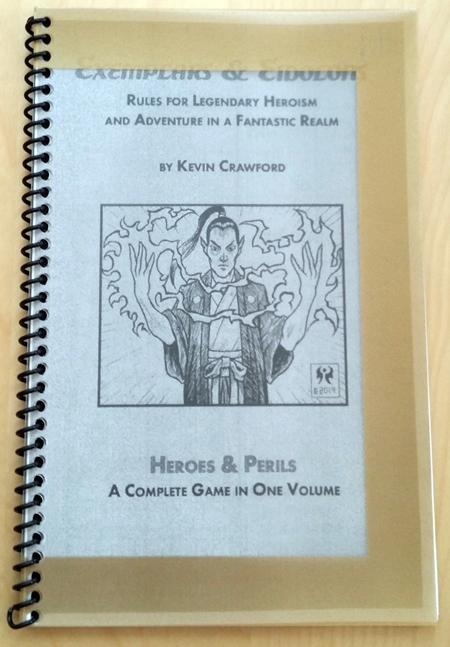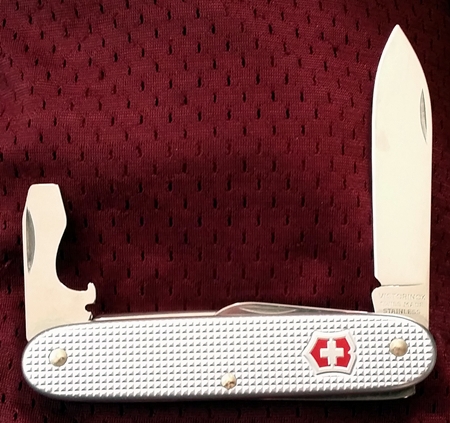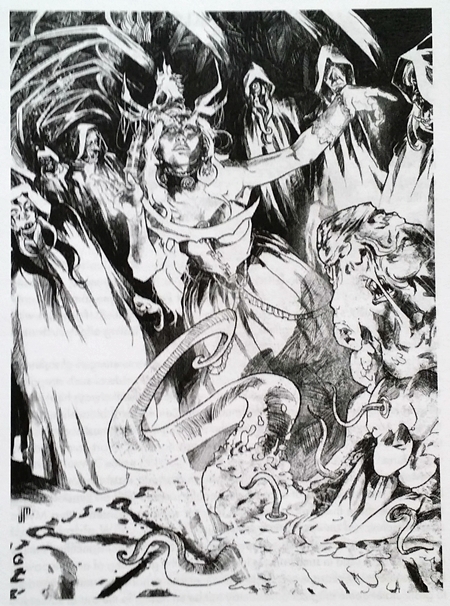I’m going to be playing Exemplars & Eidolons (paid link) next week, so I figured I’d better pick up a copy. Because Kevin Crawford is a mensch, it’s free in PDF and cheap in POD.
In a nutshell, it’s designed to mash up godlike heroes and old-school D&D adventures. Grab a D&D module, read a few numbers included therein a bit differently, and toss in E&E characters — or make your own, of course. Either way, “a single hero is transformed into a figure of towering might,” and the whole thing is delightfully rules-light.
The tacky gold stripe edition
I booklet-printed my PDF copy and took it to an office supply store for assembly. I went with a gold border because they didn’t have any plain options, and gold is fancy. Coil bound, of course, because all hail coil-bound gaming books.

It runs 47 pages, and once you subtract the covers and so forth it’s really just north of 40 — this is a game that does a lot with a little, which is something I love. And while E&E looks like a book, it’s actually a Swiss Army Knife. You know:

The larch
That Alox Electrician (paid link) was my constant companion during our 2015 move from Utah to Seattle.
It cut, pried, poked, and unscrewed all sorts of stuff while we packed up our house; it bounced along in my pocket for a thousand miles; and it broke down dozens of boxes when we arrived in Seattle. It’s one of my favorite pocket knives.
It’s compact, tough, multifunctional, and can accomplish a lot with its handful of cleverly designed tools. Which is a pretty good analogy for Exemplars & Eidolons, because just as you can do all sorts of stuff with a SAK, E&E isn’t only a game:
Exemplars & Eidolons is really an RPG book layout template. Its pages are intended to provide a basic framework for other indie game publishers who’d like to print booklets in the same vein as the original “Little Brown Books” of our gaming youth.
The PDF package comes with InDesign templates, artwork, and permission to use them as you see fit (including for commercial projects). This is basically the most Sine Nomine thing possible, and Kevin’s ability to do stuff like this while also publishing a really nifty-looking game is one of the things I love about his approach to publishing.
Under the hood
Like all the other Sine Nomine books (paid link) I’ve read[1], E&E runs on a lightweight D&D-like chassis: 3-18 for stats, classes, saving throws, hit points, yadda yadda. But, also like Kevin’s other stuff, E&E is its own thing; there are flourishes and tweaks and additions that make it tick.

(Illustration by Joyce Maureira)
Here are my favorite elements (so far):
- One-page character creation. Nine steps, one page, all neatly summarized. Yeah, you’ll need to look up a few things, but still: zippy.
- Facts. You write down three facts about your character, each one sentence long, and in play you get bonuses whenever they’re relevant. Instant flavor, player-driven worldbuilding, and mechanical heft — I dig it.
- Gifts. This is how PCs start as “figures of towering might.” Want amazing AC without armor as a rogue? Take Dodge Blows, and boom amazing AC. As a sorcerer, want to cast a low-level spell at will, as often as you like? Take Mastered Cantrip. Gifts are powered by Effort, a scarce resource which grows as you level up, keeping things interesting.
- 1st equals 5th. E&E PCs are about equivalent to 5th or 6th level old-school D&D PCs. Grab a higher-level module for an epic challenge, or enjoy grinding a mid-level one into pulp under your godlike boot-heels.
- The Fray die. Alongside anything else you do in a round of combat, you can always roll your Fray die. It’s automatic damage applied to foes within range who have fewer hit dice than you do levels. In just three short paragraphs, this mechanic goes a long way to giving the game a godlike, larger-than-life feel.
- Converting from D&D. To use a D&D monster with E&E, just treats its HD as HP; most E&E characters have single-digit hit points. 8 HD monster? 8 HP in E&E. I balk at any sort of game conversion that requires work[2], but this is so trivial it’s brilliant.
- Wealth. “Legendary heroes don’t count coppers.” Small treasures are ignored; you always have that kind of spending money. Substantial ones are worth a point or two of Wealth. Need to acquire something big, like a ship? Spend 1 Wealth.
- Problems and Influence. The basic “unit of adventure” in E&E is the problem. A problem is something that calls for heroes: plagues, invading armies, evil cults, etc. Each problem has a difficulty rated in Influence, which is E&E’s version of XP. When the PCs do Hero Stuff, they earn Influence; if they do Hero Stuff which works towards solving a problem, they can apply that Influence to the problem’s rating until it goes away. That’s a really slick way to create a setting, and adventure opportunities within that setting — and, like every other damned thing in E&E, it’s handled clearly and efficiently. E&E’s adventure and setting advice is excellent, and takes up just five pages, one of which is random tables for adventure seeds. So fucking solid.
Notice how E&E is just one letter further along in the alphabet from D&D? I don’t think that’s an accident: E&E is like D&D, one layer higher — epic fantasy on an old-school chassis, with similar expectations around creative problem-solving and making your mark on the world, but a different focus.
Exemplars & Eidolons (paid link) is a deft, clever, and efficient take on epic fantasy, marvelously lightweight and streamlined, and compatible with all things OSR. I’m excited to try it out.
[1] Favorites include Red Tide, An Echo, Resounding, and Stars Without Number (all paid links.)
[2] Because it’s fucking work.
